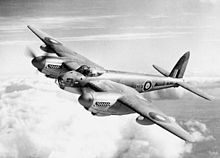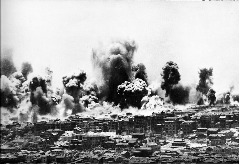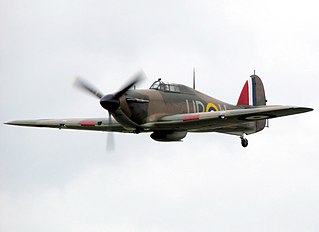This article needs additional citations for verification .(March 2017) |



A Schnellbomber (German; literally "fast bomber") is a bomber that relies upon speed to avoid enemy fighters, rather than relying on defensive armament and armor.
This article needs additional citations for verification .(March 2017) |



A Schnellbomber (German; literally "fast bomber") is a bomber that relies upon speed to avoid enemy fighters, rather than relying on defensive armament and armor.
The concept developed in the 1930s when it was believed that a very fast bomber could simply outrun its enemies. Omitting defensive armament allowed for significant reductions in drag (there would be no turrets, gondolas or gun barrels protruding from the fuselage) and weight (no guns, ammunition or manning crew members would be required on board) and resulted in improved performance.
Adolf Hitler was a staunch supporter of the Schnellbomber and directed the Luftwaffe to develop only medium bombers, but the Americans and the British developed both twin-engine medium bombers and four-engine heavy bombers. Twin-engine medium bombers, while best adapted as the Schnellbomber, lacked the payload and range of heavy bombers, which put them at considerable disadvantage for strategic bombing. In strategic bombing raids the Luftwaffe resorted to medium bombers with limited fighter escort from the Messerschmitt Bf 109 and its heavier twin-engine Bf 110 counterpart because of the lack of a truly long-range fighter. The Allies by contrast used slow but heavily-armed bombers such as the B-17 Flying Fortress deployed in combat box formation, with the long-range North American P-51 Mustang initially in escort and later in forward role conducting a "fighter sweep" to intercept attacking German fighters.
The first aircraft adopted for the Schnellbomber role was the single-engine Heinkel He 70, but it soon was replaced by the twin-engine Dornier Do 17 in that role. In the 1937 air races in Switzerland the Do 17 won a number of speed records, apparently demonstrating the value of the concept. However, experience of the Spanish Civil War demonstrated that the Do 17's speed when loaded with military equipment was insufficient to escape interception, and armament had to be added to give it some defensive fighting capability.
Bomber development temporarily outpaced fighter development in the 1930s. The last generation of biplane fighters (like the Gloster Gladiator and Polikarpov I-15) that had been placed in service during that decade could not catch the privately created Bristol Type 142 twin-engined light bomber prototype in 1935. However by the end of the 1930s, low-wing monoplane fighters like the Hawker Hurricane and the Supermarine Spitfire had entered service, and they had the performance to catch up with the Schnellbomber, and dramatically outgun it by eight to one (only one gun would normally be able to fire back). The Do 17 suffered badly at the hands of the RAF during the Battle of Britain, and its production run ended in 1940.
As World War II broke out in Asia with the Battle of Shanghai and Battle of Nanjing, [1] the Imperial Japanese Navy dispatched dozens of their unescorted Mitsubishi G3M bombers in the schnellbomber strategy of Giulio Douhet's total war concept of attacks against Chinese Air Force assets as well as civilian targets, [2] however, the strategy backfired as the Japanese underestimated the effectiveness of the Chinese air raid early-warning net and the numbers of experienced Chinese pilots leading their squadrons of Curtiss Hawk III (max-speed marginally slower than G3M) and Boeing P-26 Model 281 (max-speed marginally faster than G3M) fighters in a bloody rout against the Japanese bombers. [3] [4] Nonetheless, the total war strategy with the schnellbomber wasn't lost to the Japanese, as the Chinese lost many of their top fighter pilots by Fall of Nanking at the end of 1937, and with ever-growing Japanese blockade of war materials and high-octane aviation fuel particularly following the capture of Nanning in the Battle of South Guangxi, the increasing obsolescence of Chinese fighter aircraft burning low-grade fuel versus fast and high-flying massed bomber formations burning high-octane avgas continued to wreak havoc and devastation against Chinese cities for years to come, particularly in the Battle of Chongqing and Chengdu beginning in May 1939; [5] [6] eventually however, the United States enacted an oil and steel embargo against Japan in July 1941. [7]
The Germans nevertheless persisted in their attempts to create newer Schnellbombers, as opposed to large bombers with heavy defensive armaments which were favored by the RAF and USAAF. Other aircraft recognized as Schnellbombers by the Luftwaffe were the Junkers Ju 88, [8] the first to be custom-designed for the role, three years before the start of the war, the Messerschmitt Me 410 Hornisse in 1943, and the jet-engined Arado Ar 234 Blitz (dubbed "the fastest bomber" – "Schnellstbomber").
Several other Luftwaffe aircraft were originally designed as fast bombers, but entered service in other roles; these include the Heinkel He 219 as a night fighter, and the Dornier Do 335 — meant to have a small, ventral weapons bay to accommodate droppable ordnance from the start — as a new Zerstörer heavy fighter, faster than any other piston-twin of World War II with a top speed of some 765 km/h (475 mph). The Bomber B high-speed medium bomber design competition for the Luftwaffe started in July 1939 was meant to create an updated design to take over the original Schnellbomber role by later in World War II, and function with a heavier bombload than the earlier Schnellbomber designs were capable of carrying, but due to the intractable development problems plaguing them, the continued unavailability of the needed pair of high power output engines of 1,500 kW (2,000 hp) and above each - primarily the complex, 24-cylinder multibank Junkers Jumo 222 - needed for such designs, no production aircraft were ever ordered under the Bomber B program.
This section has multiple issues. Please help improve it or discuss these issues on the talk page . (Learn how and when to remove these template messages)
|
The most successful Schnellbomber of the war was the bomber version of the British de Havilland Mosquito. It retained a speed advantage over its enemies for much of the war and could be effectively countered only by specialist versions of various night fighter designs, with the pioneering Me 262A jet fighter being a true potential threat in 1944. The Mosquito ended the war with the lowest loss rate among any aircraft in RAF Bomber Command. The Germans considered the Mosquito as a superior implementation of their own Schnellbomber concept and as a potential inspiration for Focke-Wulf's own all-wood twin-engined, high-speed fighter design, the Focke-Wulf Ta 154 being given the name Moskito.

A light bomber is a relatively small and fast type of military bomber aircraft that was primarily employed before the 1950s. Such aircraft would typically not carry more than one ton of ordnance.

A torpedo bomber is a military aircraft designed primarily to attack ships with aerial torpedoes. Torpedo bombers came into existence just before the First World War almost as soon as aircraft were built that were capable of carrying the weight of a torpedo, and remained an important aircraft type until they were rendered obsolete by anti-ship missiles. They were an important element in many famous Second World War battles, notably the British attack at Taranto, the sinking of the German battleship Bismarck, the sinking of the British battleship HMS Prince Of Wales and the British battlecruiser HMS Repulse and the Japanese attack on Pearl Harbor.

A heavy fighter is a historic category of fighter aircraft produced in the 1930s and 1940s, designed to carry heavier weapons or operate at longer ranges than light fighter aircraft. To achieve performance, most heavy fighters were twin-engine, and many had multi-place crews; this was in contrast to light fighters, which were typically single-engine and single-crew aircraft. In Germany, these larger fighters were known as Zerstörer ("destroyer").

The Heinkel He 111 is a German airliner and bomber designed by Siegfried and Walter Günter at Heinkel Flugzeugwerke in 1934. Through development, it was described as a "wolf in sheep's clothing". Due to restrictions placed on Germany after the First World War prohibiting bombers, it was presented solely as a civil airliner, although from conception the design was intended to provide the nascent Luftwaffe with a heavy bomber.

A dive bomber is a bomber aircraft that dives directly at its targets in order to provide greater accuracy for the bomb it drops. Diving towards the target simplifies the bomb's trajectory and allows the pilot to keep visual contact throughout the bomb run. This allows attacks on point targets and ships, which were difficult to attack with conventional level bombers, even en masse.

The Junkers Ju 188 "Rächer" (avenger) was a German Luftwaffe high-performance medium bomber built during World War II, the planned follow-up to the Ju 88 with better performance and payload. It was produced only in limited numbers, due both to the presence of improved versions of the Ju 88, as well as the increasingly effective Allied strategic bombing campaign against German industry and the resulting focus on fighter production.

Schräge Musik, which may also be spelled Schraege Musik, was a common name for the fitting of an upward-firing autocannon or machine gun, to an interceptor aircraft, such as a night fighter. The term was introduced by the German Luftwaffe during World War II. "Schräge Musik" was previously a German colloquialism, meaning music that featured an unusual tuning and/or time signature. The standard usage of the adjective schräg is often translated as "slanting" or "oblique", but its slang usage is often translated as "weird" or "strange".

The Heinkel He 70 Blitz ("lightning") was a German mail plane and fast passenger monoplane aircraft of the 1930s designed by Heinkel Flugzeugwerke, which was later used as a bomber and for aerial reconnaissance. It had a brief commercial career before it was replaced by larger types. The He 70 had set eight world speed records by the beginning of 1933.

Heavy bombers are bomber aircraft capable of delivering the largest payload of air-to-ground weaponry and longest range of their era. Archetypal heavy bombers have therefore usually been among the largest and most powerful military aircraft at any point in time. In the second half of the 20th century, heavy bombers were largely superseded by strategic bombers, which were often even larger in size, had much longer ranges and were capable of delivering nuclear bombs.

A medium bomber is a military bomber aircraft designed to operate with medium-sized bombloads over medium range distances; the name serves to distinguish this type from larger heavy bombers and smaller light bombers. Mediums generally carried about two tons of bombs, compared to light bombers that carried one ton, and heavies that carried four or more.

The Focke-Wulf Fw 187 Falke ("Falcon") was a German aircraft designed in 1935. It was conceived by Kurt Tank as a twin-engine, high-performance fighter, but the Luftwaffe saw no role for the design, perceiving it as intermediate between the Messerschmitt Bf 109 and Bf 110. Later prototypes were adapted to two-seats to compete with the Bf 110 in the heavy fighter (Zerstörer) role, but only nine aircraft were built in total.

The Junkers Ju 88 is a German World War II Luftwaffe twin-engined multirole combat aircraft. Junkers Aircraft and Motor Works (JFM) designed the plane in the mid-1930s as a so-called Schnellbomber that would be too fast for fighters of its era to intercept. It suffered from technical problems during its development and early operational periods but became one of the most versatile combat aircraft of the war. Like a number of other Luftwaffe bombers, it served as a bomber, dive bomber, night fighter, torpedo bomber, reconnaissance aircraft, heavy fighter and at the end of the war, as a flying bomb.

The Mitsubishi A5M, formal Japanese Navy designation Mitsubishi Navy Type 96 Carrier-based Fighter (九六式艦上戦闘機), experimental Navy designation Mitsubishi Navy Experimental 9-Shi Carrier Fighter, company designation Mitsubishi Ka-14, was a WWII-era Japanese carrier-based fighter aircraft. The Type number is from the last two digits of the Japanese imperial year 2596 (1936) when it entered service with the Imperial Navy.
The Mitsubishi G4M is a twin-engine, land-based medium bomber formerly manufactured by the Mitsubishi Aircraft Company, a part of Mitsubishi Heavy Industries, and operated by the Imperial Japanese Navy from 1940 to 1945. Its official designation is Mitsubishi Navy Type 1 attack bomber and was commonly referred to by Japanese Navy pilots as Hamaki due to the cylindrical shape of its fuselage and its tendency to ignite after a hit. The Allied reporting name was "Betty".

The Junkers Ju 288, originally known within the Junkers firm as the EF 074, was a German bomber project designed during World War II, which only ever flew in prototype form. The first aircraft flew on 29 November 1940; 22 development aircraft were eventually produced.

The bombing of Chongqing, from 18 February 1938 to 19 December 1944, were massive terror bombing operations authorized by the Empire of Japan's Imperial General Headquarters and conducted by the Imperial Japanese Army Air Service (IJAAF) and Imperial Japanese Navy Air Service (IJNAF). Resistance was put up by the Chinese Air Force and the National Revolutionary Army's anti-aircraft artillery units in defense of the provisional wartime capital of Chongqing and other targets in Sichuan.

The Mitsubishi G3M was a Japanese bomber and transport aircraft used by the Imperial Japanese Navy Air Service (IJNAS) during World War II.

The Battle of Britain was an effort by the German Air Force (Luftwaffe) during the summer and autumn of 1940 to gain air superiority over the Royal Air Force (RAF) of the United Kingdom in preparation for the planned amphibious and airborne forces invasion of Britain by Operation Sea Lion. Neither the German leader Adolf Hitler nor his High Command of the Armed Forces believed it was possible to carry out a successful amphibious assault on Britain until the RAF had been neutralised. Secondary objectives were to destroy aircraft production and ground infrastructure, to attack areas of political significance, and to terrorise the British people into seeking an armistice or surrender.
Mitsubishi Aircraft Company was the new name given by the Mitsubishi Company, in 1928, to its subsidiary, Mitsubishi Internal Combustion, to reflect its changing role as an aircraft manufacturer catering to the growing demand for military aircraft in Japan.
The schnellbomber technique was what the Japanese needed in the penetration of Chinese airspace with superior speed to avoid fighter interception and drop their bombs in safety.
Japanese advances in high-octane engine technology and supercharging greatly increased the obsolescence of Chinese fighter aircraft burning low-octane fuel.